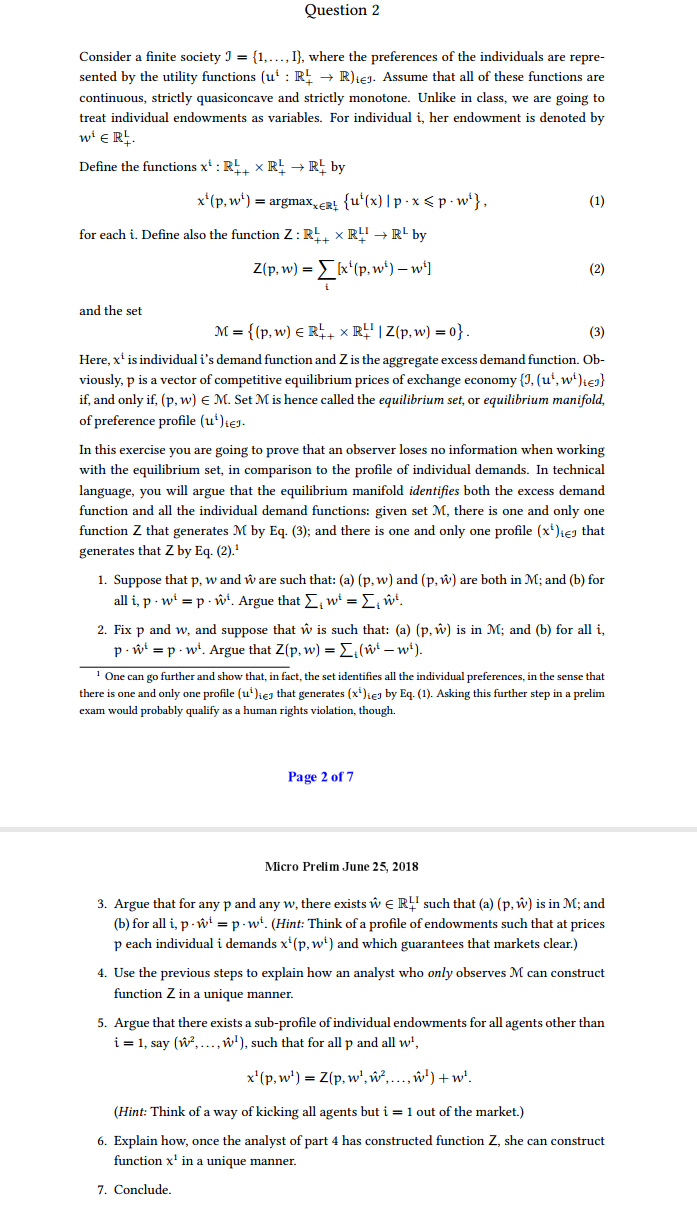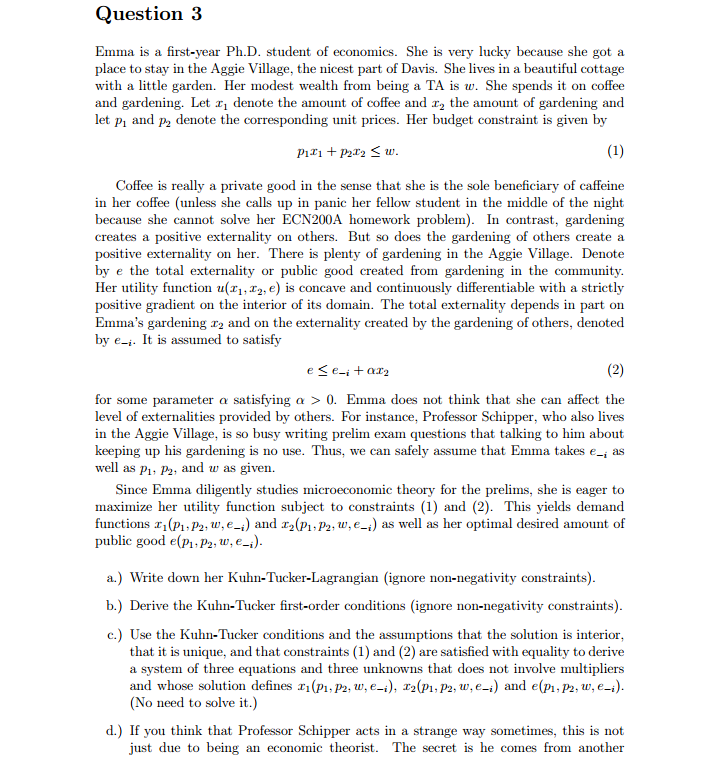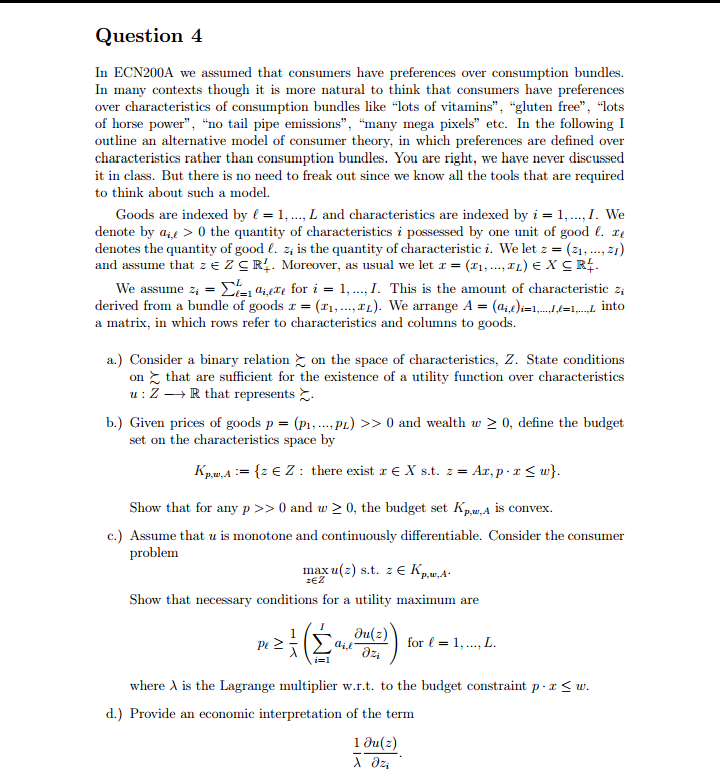


Solve the all....with Right answers
Question 2 Consider a finite society ] = {1,..., I), where the preferences of the individuals are repre- sented by the utility functions (ul : R4 - R)iej. Assume that all of these functions are continuous, strictly quasiconcave and strictly monotone. Unlike in class, we are going to treat individual endowments as variables. For individual i, her endowment is denoted by WER Define the functions x' : R4 x R4 - R4 by x' (p, w') = argmaxxER! {u'(x) |p - x
RL by Z(p, w) = [ lx'(p, w') - w'] (2) and the set M = {(p, W) ER+ + x R.' | Z(p, w) = 0}. (3) Here, x' is individual i's demand function and Z is the aggregate excess demand function. Ob- viously, p is a vector of competitive equilibrium prices of exchange economy {], (ut, wiles} if, and only if, (p, w) E M. Set M is hence called the equilibrium set, or equilibrium manifold, of preference profile (u')ieJ. In this exercise you are going to prove that an observer loses no information when working with the equilibrium set, in comparison to the profile of individual demands. In technical language, you will argue that the equilibrium manifold identifies both the excess demand function and all the individual demand functions: given set M, there is one and only one function Z that generates M by Eq. (3); and there is one and only one profile (xthey that generates that Z by Eq. (2).' 1. Suppose that p, w and ware such that: (a) (p, w) and (p, w) are both in M; and (b) for all i, p . wi = p . wi. Argue that ), wi = _, wt. 2. Fix p and w, and suppose that w is such that: (a) (p, w) is in M; and (b) for all i, p . w = p . w. Argue that Z(p, w) = Z(wi - wi). 1 One can go further and show that, in fact, the set identifies all the individual preferences, in the sense that there is one and only one profile (u' lies that generates (x Jigg by Eq. (1). Asking this further step in a prelim exam would probably qualify as a human rights violation, though. Page 2 of 7 Micro Prelim June 25, 2018 3. Argue that for any p and any w, there exists we Ry such that (a) (p, w) is in M; and (b) for all i, p - wi = p. w. (Hint: Think of a profile of endowments such that at prices p each individual i demands x' (p, w' ) and which guarantees that markets clear.) 4. Use the previous steps to explain how an analyst who only observes M can construct function Z in a unique manner. 5. Argue that there exists a sub-profile of individual endowments for all agents other than i = 1, say (we, ..., w ), such that for all p and all wi, x' (p, w' ) = Z(p, w', w/,..., w') + w. (Hint: Think of a way of kicking all agents but i = 1 out of the market.) 6. Explain how, once the analyst of part 4 has constructed function Z, she can construct function x' in a unique manner. 7. Conclude.Question 3 Emma is a first-year Ph.D. student of economics. She is very lucky because she got a place to stay in the Aggie Village, the nicest part of Davis. She lives in a beautiful cottage with a little garden. Her modest wealth from being a TA is w. She spends it on coffee and gardening. Let z, denote the amount of coffee and r, the amount of gardening and let p, and p, denote the corresponding unit prices. Her budget constraint is given by Piti + per2 5 w. (1) Coffee is really a private good in the sense that she is the sole beneficiary of caffeine in her coffee (unless she calls up in panic her fellow student in the middle of the night because she cannot solve her ECN200A homework problem). In contrast, gardening creates a positive externality on others. But so does the gardening of others create a positive externality on her. There is plenty of gardening in the Aggie Village. Denote by e the total externality or public good created from gardening in the community. Her utility function u(1 1, 12, e) is concave and continuously differentiable with a strictly positive gradient on the interior of its domain. The total externality depends in part on Emma's gardening r2 and on the externality created by the gardening of others, denoted by e-;. It is assumed to satisfy ese-it of2 (2) for some parameter a satisfying o > 0. Emma does not think that she can affect the level of externalities provided by others. For instance, Professor Schipper, who also lives in the Aggie Village, is so busy writing prelim exam questions that talking to him about keeping up his gardening is no use. Thus, we can safely assume that Emma takes e_; as well as p1. P2, and w as given. Since Emma diligently studies microeconomic theory for the prelims, she is eager to maximize her utility function subject to constraints (1) and (2). This yields demand functions I,(P1, P2, w, e_;) and I2(P1, P2, w, e_;) as well as her optimal desired amount of public good e(p1 , P2, w, e-;). a.) Write down her Kuhn-Tucker-Lagrangian (ignore non-negativity constraints). b.) Derive the Kuhn-Tucker first-order conditions (ignore non-negativity constraints). c.) Use the Kuhn-Tucker conditions and the assumptions that the solution is interior, that it is unique, and that constraints (1) and (2) are satisfied with equality to derive a system of three equations and three unknowns that does not involve multipliers and whose solution defines ri(p1, p2, w, e-;), 12(p1, pz, w, e-.) and e(p1, p2, w, e-;). (No need to solve it.) d.) If you think that Professor Schipper acts in a strange way sometimes, this is not just due to being an economic theorist. The secret is he comes from anotherQuestion 4 In ECN200A we assumed that consumers have preferences over consumption bundles. In many contexts though it is more natural to think that consumers have preferences over characteristics of consumption bundles like "lots of vitamins", "gluten free", "lots of horse power", "no tail pipe emissions", "many mega pixels" etc. In the following I outline an alternative model of consumer theory, in which preferences are defined over characteristics rather than consumption bundles. You are right, we have never discussed it in class. But there is no need to freak out since we know all the tools that are required to think about such a model. Goods are indexed by / = 1, ..., L and characteristics are indexed by i = 1, ..., I. We denote by a; > 0 the quantity of characteristics i possessed by one unit of good . If denotes the quantity of good 6. z, is the quantity of characteristic i. We let = = (21, ..., 27) and assume that z e Z C R. Moreover, as usual we let r = (21, .... II) EX CR+. We assume 2 = 2 diet for i = 1, ..., I. This is the amount of characteristic z; derived from a bundle of goods I = (T1, ..., IL). We arrange A = (ait)izl,.,1,/=1...,L into a matrix, in which rows refer to characteristics and columns to goods. a.) Consider a binary relation > on the space of characteristics, Z. State conditions on _ that are sufficient for the existence of a utility function over characteristics u : Z - R that represents _. b.) Given prices of goods p = (P1, ...; PL) > > 0 and wealth w 2 0, define the budget set on the characteristics space by Kow,A := {= c Z : there exist r ( X s.t. = = Ar,p. ISw). Show that for any p > > 0 and w 2 0, the budget set Kow,A is convex. c.) Assume that u is monotone and continuously differentiable. Consider the consumer problem max u(z) s.t. z E Kpu,A. Show that necessary conditions for a utility maximum are pe 2 du (2) for { = 1, .... L. where A is the Lagrange multiplier w.r.t. to the budget constraint p. r S w. d.) Provide an economic interpretation of the term 1 du(z) A dzi












